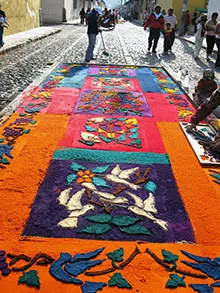
Sunday, March 21st, I got up before dawn and was out the door by 5:30 a.m. Paulino, who complains that he is the only one of Ana Luisa’s children for whom I am not a godmother, and I were off to see alfombras (As I mentioned in the Sta. Inez blog post, alfombras “literally, rugs” are artistic creations generally made from colored sawdust or from pine needles and flowers. Many other materials can be used to supplement these basics. The police had blocked 3ra calle, the main town entryway for light vehicles so that residents could work on their creations without being run over. This pushed all traffic from the capital onto my street. At 5:30 a.m. the stream of cars was steady but spread out, by 9 a.m. cars were squeezing through two and three abreast, bumper to bumper. This inflow continued apace through dusk. Radio reports, based on parking permits sold, put the number of visiting vehicles at 10,000 for the day.
Paulino and I quickly ducked down 3ra calle. People had the base for the rugs laid out, leveling the convex crowning of the road, but were just beginning to work on designs. The procession would not pass down 3ra until 2 in the afternoon. They had hours ahead to work. Paulino and I headed for San Bartolomé Becerra, the suburb from which the procession would emerge. When we got over to 7ma calle, the first of Antigua’s streets that the cortege would reach, many rugs were underway.
We crossed the Alameda Sta. Lucía and found the hermitage chapel there open, a rarity. There was a rug, part pine and wood shavings, part sawdust, laid out in the approach to the portal. Inside the church, a vigil scene had been prepared, with the legend “Crucify him! Crucify him!” Before the tableau, a large sawdust rug depicted a chrysanthemum mandela. The rug was bordered with oranges, other fruits and vegetables complimented the design. Arrays of flowers completed the display.
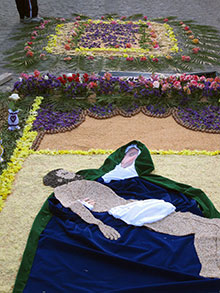
From the hermitage we walked down the road toward San Bartolomé Becerra. Alfombras became more closely spaced. A popular theme was Jesus’ baptism by John. The artists devised ingenious ways to supply running water for the river Jordan. In one baptismal scene, it appeared that a Barbie (not a Ken) had been re-gendered, given a black painted beard and a wild man set of dreads, thus, representing John, the Baptist. Another baptism sported real water hyacinths, being pollinated by hummingbirds constructed from rootlets. I asked the creator of this masterpiece how long it had taken him. He replied, “Seven hours”. It was just past 6 a.m. Of course, the procession leaves the church sanctuary at 7 a.m., and this man’s home lay in the first kilometers of the route. The men carrying the Fallen Jesus, the miraculous Christ figure of San Bartolomé Becerra, would cross over his creation by 7:45. His work would be but a memory, though doubtless preserved by many photographers like me. These fantastic fabrications are ephemeral art, offerings of faith and love.
Another man had created a rug captioned, “The Parable of the Lost Sheep”. The cotton ball-y sheep were tended by a mobile shepherd. The artist/engineer moved the sheepherder along a track by turning a crank. Another artisan had created a miniature procession using clay to mold the figurines, and balsa and paint to build the mini-float and provide the “ground”. The whole image was a barefoot in length, with 45 tiny actors depicted.
Other striking scenes included (a) a long scene showed the planting and harvest of wheat. Real wheat sprouts were laid out in rows, blending into the fields drawn in sawdust. Mature wheat stalks were held by harvesters. (b) An alfombra portraying Jesus carrying his cross was constructed using flowers, with a real bark cross and banana “wood” hands and face. (c) A pieta with a lifelike face painted on cloth and molded into three dimensionality, cradled her dead son. (d) A sylvan scene was bordered by scrollwork made from cashew fruits. (e) Several beautiful geometric arrangements of cut flowers, fruits, vegetables and bouquets were interspersed along the pathway.
As we neared San Bartolomé Becerra’s central square the crowds thickened. Vendors along the roadway offered breakfast delights of grilled meat, beans, various atoles “gruels”, enchiladas, tortillas stuffed with cheese or cracklings, sandwiches, fruit, soft drinks, and candies. Others hawked visors and sunglasses as protection from the finally rising sun. A brisk business was being done in white gloves, as the men carrying the Christ image would need to cover their hands to protect the wood from acids and oils. Mantillas and madrilènes, head-covers for women were also being sold. Balloons and toys for children were also popular. Several men held racemes of doll-like rattles in the form of the men who would carry the Christ float, though I heard a bearer standing behind me, mutter that the dolls were attired like the bearers from the Mercedarian church in Antigua, with white headcloths, rather than the purple worn by San Bartolomé Becerra bearers.
Let me introduce you to the “players” in these processions, as I’ll no doubt also report on the pageantry of this coming week-end and then the culmination on Good Friday.
Dramatis personae:
Cucuruchus – These are the male bearers. Those who carry the floats and images during Lent and during the morning on Good Friday wear purple, representing the passion and majesty of Christ. Those who bear the dead Christ figure on Friday afternoon and evening wear black. The attire consists of a cassock, a headcloth and agal, and gloves.
Judíos – These are leaders of the confraternities that organize the procession. They are responsible for organizing the turns, for steering the floats, for making sure that no bearer falls and that the image never hits the ground or gets caught up in electrical wires. Many wear headphones with mikes or use blueteeth to coordinate the progress along the route. Their robes may be white, with purple or red agals or purple with white surplices. They are also responsible for deciding when to turn on the lights, those that illuminate the floats at light, and those that are carried by the cucuruchus. The judíos must also trundle the mobile generators along the streets. Recall all the streets of Antigua are cobblestone.
Nazarenos – These, somewhat ironically, are the Pharisees. They wear maroon cassocks with cream surplices. Their headdresses, however, are KKK-like maroon duncecaps, with veils that cover their faces.
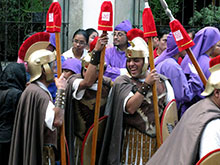
Romanos – Well, they are Romans. They carry Roman swords and shields. Some carry Roman army standards, some of which are used to lift the electric lines out of the way of the cross. The San Bartolomé Becerra army has a Roman band that plays in front of the cathedral in Antigua for the “sentencing” of Jesus.
Devotas – Women who carry Mary.
Aspirantes – These are children, even babies, who dress as cucuruchus, and “aspire” to grow up to carry Jesus.
Orquesta – A band that plays funereal music throughout the trajectory of the procession follows Jesus; another follows Mary. The band members have helpers to roll the tympani along and to hold ropes around their marching space to allow them to process through the throngs.
Order of appearance: The Romans come first. They are followed by some Nazarenos. On Good Friday, Jesus will be preceded by Pontius Pilate and the two thieves to be crucified with him. Cucuruchus line the route, keeping a path clear for the float and its bearers. All these early characters walk along the edges of the roadway, leaving the alfombras intact. Jesus, carried by his cucuruchus, passes over the rugs, swirling the rugs’ sawdust and flowers into colorful disarray. Jesus is followed his orquesta, which, in turn, is followed by Peter, Mary Magdalene, and his mother, and her band. These groups are free to move along the center of the road as the rugs are now merely cobblestone padding.
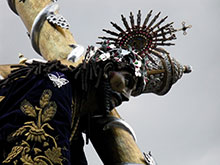
The Fallen Christ of San Bartolomé Becerra is a miraculous icon and attracts myriad cucuruchus. This year 4,000 cucuruchus paid (The devotas and aspirantes also pay for the privilege of donning their attire and processing.) for the honor of carrying this image from San Bartolomé Becerra to Antigua, then to the major Catholic churches and shrines within the city. The procession emerged right on time at 7 a.m. Sunday. Christ re-entered his church at 2 a.m. on Monday.
So, anyway, Paulino and I reached the Church plaza by 6:40 a.m. We picked a vantage point with a view of the church doorway, but with a direct line to an exit route, as we wanted to see the emergence and then dash back to Antigua to see how the rugs that would be destroyed later were developing. I was glad to have gringa height. I had a fairly clear line of sight, despite people in front of me boosting their children to their shoulders. The church bells tolled. The float began to emerge. There was some maneuvering at the doorway, as the whole float had to be lowered to allow the cross and the statue of Jesus to pass through. This float has forty “shoulders” per side. Three judíos direct the float from the front; another three from the rear. One judío splays his arms, grasping two knobs in the front, to coordinate the sway that allows the bearers to shuffle forward together. The float emerged, made a stately left turn, and began the processional way.
Paulino and I headed back to town. Paulino wanted to smoke a cigarette; I wanted a mango; so we took a short break.
Back in town, the rugs had progressed. The owner of a Peruvian restaurant had constructed a rug depicting Machu Picchu. He had let the cobbles of the street show through where the masonry of the ruins would be. The Andean peaks, he had traced in green and pine, a striking composition.
Other interesting compositions: (a) Red bell peppers and cabbage leaves formed Jesus body; his hair – a real wig. (b) Loaves of French bread formed the bodies of butterflies, flitting among colorful sawdust flowers. (c) Plastic bottle tops had been dyed and cut to become flowers, with gelatin balls as dewdrops. (d) Sewing scraps became colored confetti forming a frame for the more traditional constructions of sawdust.
A riot of color, a blend of geometric figures, flowers, and biblical scenes were laid out along the processional route. Jesus would pass inexorably over the city’s offerings. As Paulino and I made our way back up to the house, the pace of work was intensifying on the rugs on 3ra calle. Time was getting short; Jesus was on his way.
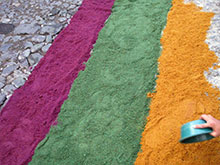
Paulino and I got back to the house by 9:30 a.m. We had paches (Potato-dough tamales.) for breakfast. I showered, changed clothes, and recharged by camera batteries. We set out in the early afternoon again with my goddaughter, Gabriela, her son José Paúl, and her baby Saúl Andrés. We watched the procession move down 3ra, wiping up the just completed alfombras. We dropped Gabriela and sons back at the house and coaxed my comadre, Ana Luisa out of the house, catching up with the procession on 5th Avenue, just off the central square. The censors were sending clouds of aromatic smoke skyward for a block in front of Jesus. Cucuruchus clearing the path were blinking and coughing, occasionally using their headcloths to filter air. The group of devotas carrying Mary through this stretch were all Kaqchikeles, wearing black üqs (An üq is a traditional woven Mayan skirt. In the Kaqchikel area, eight varas (vara ≈ a short meter) of cloth is wrapped rather than sewn and is secured with a wrapped and tucked stiffly woven belt.) and mantillas. An accompanying set of devotas wore full ceremonial tzyäq (Tzyäq is Kaqchikel for “clothing”. Ceremonial garb for women consists of the üq, belt (pa’s), woven blouse (po’t), and headcloth (su’t).). Their brilliant colors and intricate designs provided vivid counterpoint for the somber black of those carrying Mary.
Ana Luisa and Paulino headed back up the house, so Ana could get supper on the table. I spent another hour on the streets, running ahead to see alfombras, meeting up with the procession, and darting ahead again. I got up to house around 7 p.m., leaving Jesus to complete his rounds and return to San Bartolomé Becerra nineteen hours after his emergence. A day of pageantry and devotion.

